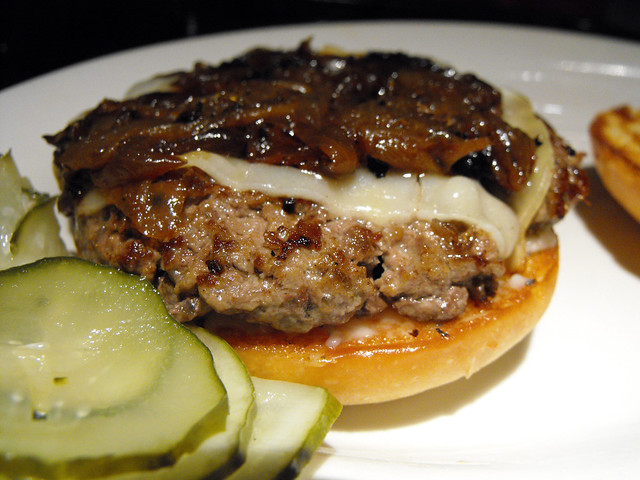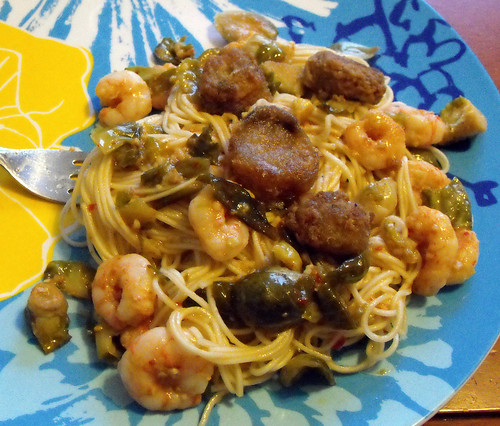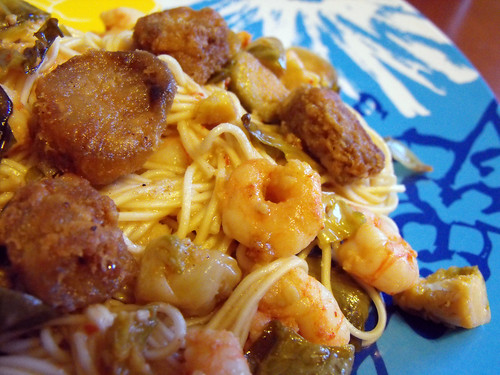Lent is coming up. Lent, of course, will mean giving up meat. Even more of course, the weeks BEFORE Lent mean "oh holy hell, what meat do I need to make sure to eat while I can?"
I'll make a few burgers. I'll fry some chicken. I'll have some pig tails with barbecue sauce. But first I made meatballs and spaghetti.
The fundamental techniques I use to make meatballs are the ones I learned from my mother many years ago,
as you likely rely on those you learned from yours: combine ground
beef and ground pork (I like to add ground lamb but it's often
prohibitively expensive), season, bind with breadcrumbs and egg;
brown and simmer in tomato sauce. (There you go, there's your recipe content for this post.) I might do any manner of other
things - when I can, I leave the mixed meat in the fridge overnight
before browning - I often add buttermilk or Greek yogurt, and for years I always added vermouth - garlic,
marjoram, and fennel are frequent seasonings - but the basic
technique has not changed. Sometimes I shake some crushed red peppers onto my plate, the way my mother always put on her pizza.
There's a reason this is a dish we so often learn from our parents or grandparents. There is an argument to be made for
meatballs and spaghetti as the quintessential American dish, one
borne not out of the 17th and 18th centuries when kings were granting
land for colonies run by aristocrats who starved because they hadn't brought enough laborers to fish and farm for them, but out of the splash of decades - 1880s to 1920s
- that historian Robert Wiebe calls the organizational period, when
modern American identity was really formed. The dominance of the
Union over its States had been affirmed in an agonizing war and
Reconstruction; the political issues driving elections were
increasing national in their concern (monetary policy, foreign
policy, immigration) rather than regional; national unions, guilds,
and professional organizations became common; people begin reading
nationally distributed magazines and newspapers from nationally owned
chains with nationally syndicated content. Business expands to the
national level - Standard Oil, Carnegie Steel. Railroads and the
close of the frontier make travel more common - at the same time,
urbanization and higher education make Americans more mobile, by
untethering their means from a particular parcel of land and making
it more likely that they will move away from home to find jobs. This is when people start thinking of themselves as Americans instead of Mainers or Virginians or Hoosiers.
At the same time, the ethnic makeup of
the country changes drastically. Italians are lynched, Irish Need Not
Apply, Chinese are routinely driven out of town by mobs, and the
influx of Catholics and Jews is one of the motivating factors behind
the creation of the second, and most successful, Ku Klux Klan. Phase changes take a lot of energy.
This is when cookbooks become really
popular, and magazines and newspapers expose readers to new recipes nationwide, instead of just preserving local traditions.
You have a lot of new foods
- not just foods from other cuisines, but packaged foods in the
aftermath of the Industrial Revolution, refrigerated foods as the
country is electrified (and the ice trade improves even in those
areas which lag behind), and ...
Ground beef.
When talking about burgers, I pointed
out that the reason hamburgers land where they do in the timeline is
because the modern beef industry, or perhaps its immediate precessor,
was the child of the railroads, which allowed cattle and cattle
carcasses to be transported far enough and fast enough that beef
became cheaper and more widely available. Ground beef, especially in
the early 20th century, became a much more common product as a
result, something that could be sold cheaply because the steaks had
already paid for the cow - in some cases it was used in recipes which
had traditionally used finely chopped or braised meat (chili con
carne, spaghetti with "meat sauce"); in others, new foods
emerged.
Meatballs were not quite new, not
exactly. But neither were they ever as common in Italy as they became
in the United States, especially in this form: golf-ball-sized, red-sauced, spaghettied. We adopted ground beef earlier than other
cultures; our cuisine was already in flux because of immigration,
technology changes, and population shifts; the Italian-American
communities tended to cook more tomato-heavy dishes than their
cousins back home did, and perhaps more importantly,
non-Italian-Americans responded very positively to those tomato-heavy
dishes. Before long we've got meatball grinders, meatball pizza, meatball Hot Pockets.
Meatballs and spaghetti is the great
success story when it comes to ethnic food in America, because no one
really thinks of it as ethnic food anymore - families without
a drop of Italian blood in them have been making them long enough to
have family recipes that have been passed down for generations. Even
in the 1950s - one of the whitest, Protestantest, meatloafiest times
in American history - Wednesday was Prince spaghetti day.
Like the hamburger, pepperoni pizza, or
the ice cream cone, meatballs and spaghetti is a dish that took a
European kernel, adapted it to American circumstance, and created a
mainstream icon that transcended its origins.













